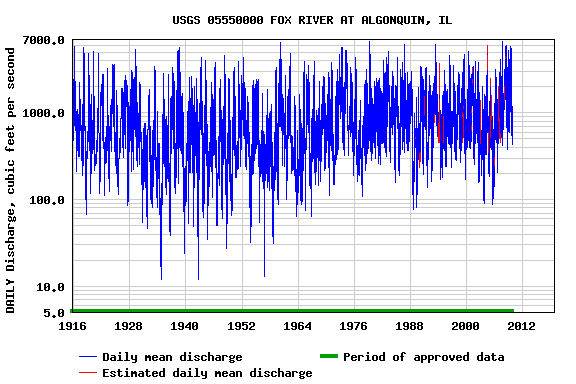By Art Malm, FOTFR Board Member

Will the river stop flowing altogether in dry years if the low head dams like the one at Carpentersville are removed?
“I remember back in the 60’s when we walked across the top of the Carpentersville dam and it was dry”. This was the memory of a gentleman who stopped in at the Friends of the Fox River’s booth at West Dundee’s Heritage Fest earlier this month. Well, might the Fox run dry in Carpentersville if we remove the dam?
The United States Geological Survey (“USGS”) doesn’t have a history of flows over the Carpentersville dam. It does though have data for the Fox River at Algonquin back to 1915. The data looks like this:
Our visitor at the Heritage booth had a good memory. In fact, the summer of 1964 was a very dry one. USGS data shows the minimum flow of the Fox at Algonquin to have been 97.0 CFS (cubic feet per second) on June 9, 1964 or 38.8 million gallons per day. The “mean” or average flow of the Fox is 415 million gallons per day. If the dam weren’t there he may have been able to wade across the river, but not without getting his pants wet.
The statement about his walking across the top of a dry dam though is an interesting one which some hydrology historian might want to research. One possible answer might be leakage through the old mill race.
The lowest flow of the Fox in the Algonquin dam database appears to be August 30, 1934 at 12 CFS. For reasons currently unknown to the writer USGS considers the actual minimum flow to have been 45.0 CFS in 1958. In any event we are unlikely to see flows at Algonquin that low again in the future.

When the Stratton dam’s gates were installed in 1939 it allowed control of the water level of the Chain of Lakes. Since that time river flows below this dam have been to a greater or lesser extent controlled by the dam operator whose focus is maintaining the optimum water level in the Chain. Armed with better records, procedures and weather forecasting (and with the cities of Elgin and Aurora now depending upon the Fox for their public water supply) it is hard to imagine the Fox ever running dry at Carpentersville, with or without its low head dam.
If YOU have a question about the impacts of the low head dams on our Fox, or their removal, please post it in the comment section below.



Do you have an estimate of the volume the many water reclamation districts along the Fox are contributing to the down river flows? I’ve heard rumors that sewage plants are the only thing keeping water flowing into the Fox during some of the drier years. This seems far fetched to me… but I’m sure they are contributing factors nonetheless.
Jeremy,
Here’s what our Treasurer and retired director of Elgin’s public water supply says:
“During the drought of 2012, I would have to agree with the fact that the waste water treatment plants were the only thing keeping the river running.
Finding out how much each community discharges into the river is actually quite simple. I think the Fox River Study Group has all that data. I know the City of Elgin with draws around 20,000,000 gallons a day for drinking water and the district discharges about double that back.”
I looked for the discharge data on the FRSG’s website & couldn’t find any.
The % of effluent in the river is, on average, pretty constant. What varies is the amount of natural flow from groundwater and stormwater. When the river is high, even if treatment plants are discharging untreated wastewater, the % of effluent is not significant. But when the river is low, the discharges can be more than 60% of the volume. It never gets near 90% even in the lowest flows.
Gary Mechanic, Executive Director